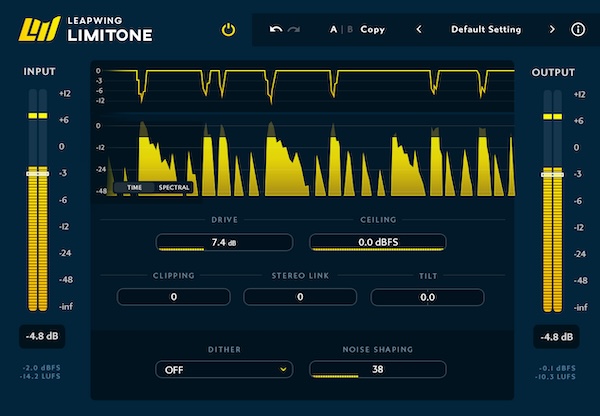
| Back To The Directory |
Leapwing Audio LimitOne
By Barry Rudolph
 |
| Leapwing Audio LimitOne Graphical Interface |
LimitOne is a transparent dynamic processor and the latest plug-in from Leapwing Audio. It uses two algorithms to dynamically control any audio from individual tracks to full mixes. The inherent deficiencies and limitations of two-stage limiters and multi-band compressors, clipping, unwanted coloration, and other artifacts are addressed using newly designed algorithms.
Two software processors, (playfully) codenamed Pufferfish and Hedgehog, work together to optimize sound energy in both the frequency and time domains. These were internal codenames (how Leapwing typically describe internal R&D projects). But since it was impossible to give them a specific "technical" name that made any sense, Leapwing decided to leave it.
LimitOne's internal signal chain starts with a Tilt input filter that constrains both the high and low frequencies for focusing or weighting gain reduction. This is especially important when using it on individual instruments or vocal tracks. For bass guitar I would set Tilt to negative values to focus on low frequencies more. But as way to color the sound, I used positive values to emphasize pick attacks that is unlike using an equalizer.
Tilt is a way to color the sound with non-linear gain reduction related to frequency. I found for full mixes little or no change of Tilt's default value of 0 was necessary. Using Tilt is a song-by-song option and it is a good tool for experimentation on full mixes and individual tracks.
Next in the chain is Pufferfish that assesses sound energy and optimizes it across the entire 20Hz to 20kHz spectrum. Depending on the settings of the two main controls, Drive and Ceiling, appropriate multi-band dynamic control is applied predicated on the distribution of spectral energy.
Hedgehog, next in the chain, shapes or reshapes transients often lost in other dynamic processors when reducing dynamic range in the quest for maximum loudness. Hedgehog is also governed by the Drive and Ceiling settings and applies adaptive dynamic control instantaneously by working with the spectral information provided by Pufferfish
I soon realize that the two-way, interaction between Pufferfish and Hedgehog is the secret to LimitOne's transparent operation.
The Drive control is an internal signal booster--more Drive equals lower LUFS. This is basic: just crank Drive and get it loud! The Clipping parameter adjust the mix between Pufferfish and Hedgehog. The default is 0 and higher values result in more aggressive clipping. I tried Clipping set to 100, the maximum, on a solo nylon acoustic guitar track. I was looking for less dynamic range to keep it upfront, present and clear without just making it too loud and overpowering the track. Most importantly, I didn't want it to sound squashed. This worked fantastic! I still had to do some minimal gain riding.
Drive's setting depends on the signal input level as well as Input Level fader setting. The input level meter reads in K-Weighted loudness in LUFS and I didn't need to adjust the Input level fader unless the incoming audio was very low level. Lastly, Stereo ink allows full linkage or not between left and right channels to keep the center image stable.
LimitOne is a 64-bit plug-in for VST3, AAX, and AU formats and requires Mac OS 10.13 or higher and Window 10 or 11. Just before the output is an optional 16 or 24-bit dithering with noise-shaping system; it works with sample rates up to 384kHz for DXD releases. GUI
I found the GUI very informative and tutorial by showing exactly what, where, when and how much LimitOne is working at all times. In Time mode, you can monitor using a constantly moving, running history of gain reduction in dB with the audio's waveform showing its shape and where the audio peaks hit the "wall" at 0.0 dBFS or whatever max loudness specification the project requires.
The top line represents the output at max level set with the Ceiling control--the default at 0.0 dBFS. Once music starts, you can see momentary gain reductions as dips below 0dBFS and also track the "shape" as the level climbs back up towards 0.0 dBFS during the limiter's release time. When using LimitOne as a stereo bus processor, you can adjust the Tilt control while looking at the dips in gain reductions usually with each loud bass drum it--for example. I liked that you click and hold on any spot in the waveform and immediately read the input and output levels and momentary gain reduction.
In Spectral mode, you'll see exactly the frequencies affected by limiting--especially under extreme Drive control settings. When using high Drive settings, the spectrum brightens to better see "flat topping" peaks.
Other Uses
I tried LimitOne on every track in my mix. I found it excellent for guitars--acoustics, electric leads and rhythms. I like it on the stereo mix bus for instantly higher LUFS. I liked it on lead vocals to keep a "lid" on overall peaks that allows for natural-sounding gain riding on quieter sections.
Leapwing LimitOne is a modern solution to an age-old problem for audio engineers/producers. It easily produces louder mixes with nearly transparent quality and with minimal distortion.
Leapwing Audio LimitOne is now available for $249 MSRP
|
|
|